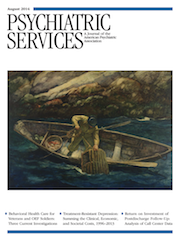Use of Outpatient Mental Health Services Among Children of Different Ages: Are Younger Children More Seriously Ill?
Abstract
Objective
The study compared use of specialty outpatient mental services among children ages six and seven and children ages eight through 12 and investigated predictors of differences in the patterns of service use by age.
Methods
Eligible children were first-time patients of clinics participating in the Longitudinal Assessment of Manic Symptoms who were between ages six and 12 and who were English speaking. Children who screened positive for symptoms of mania (N=1,124) were invited to participate, and families of 621 (55%) children consented. A matched sample of 86 children without a positive screen for mania also participated. Baseline interviews assessed sociodemographic characteristics of the child and family and the child’s functioning, diagnoses, and use of services.
Results
Of the 707 children, 30% were younger, and 50% used multiple types of specialty outpatient services. Younger children were more likely to be male, have Medicaid insurance, and have two parents with mental health problems. Use of multiple types of services was related to study site, high depression scores, fewer minor health issues, and fewer stressful life events among younger children and with parental stress, primary diagnosis, poor functioning, and not living with both parents among older children. Younger children were much more likely than older children to have used services before age six.
Conclusions
Younger children showed very early use of multiple types of services for mental health problems and a pattern of persistent impairment despite long-standing use of services. These data argue strongly for focusing on emotional and behavioral issues among young children.



